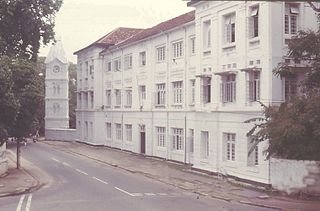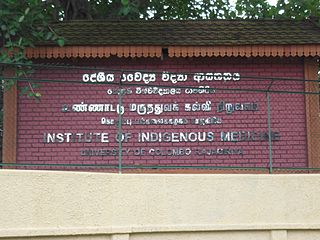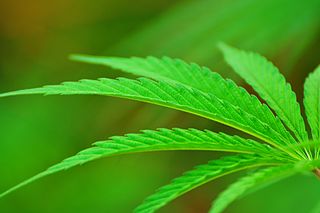Related Research Articles

Ayurveda is an alternative medicine system with historical roots in the Indian subcontinent. It is heavily practiced in India, Nepal, Bangladesh, Pakistan and Sri Lanka, where as much as 80% of the population report using ayurveda. The theory and practice of ayurveda is pseudoscientific; some ayurvedic medicines have been found to contain toxic substances.

Bhang is an edible preparation made from the leaves of the cannabis plant originating from the Indian subcontinent. It has been used in food and drink as early as 1000 BC in ancient India. Bhang is traditionally distributed during the spring festival of Maha Shivaratri and Holi. Bhang is mainly used in bhang shops, which sell the cannabis-infused Indian drinks bhang lassi and bhang thandai.

The Narcotic Drugs and Psychotropic Substances Act, 1985, commonly referred to as the NDPS Act, is an Act of the Parliament of India that prohibits a person the production/manufacturing/cultivation, possession, sale, purchasing, transport, storage, and/or consumption of any narcotic drug or psychotropic substance. The bill was introduced in the Lok Sabha on 23 August 1985. It was passed by both the Houses of Parliament, received assent from then President Giani Zail Singh on 16 September 1985, and came into force on 14 November 1985. The NDPS Act has since been amended four times — in 1988, 2001, 2014 and 2021. The Act extends to the whole of India and it applies also to all Indian citizens outside India and to all persons on ships and aircraft registered in India.
Sri Lanka has its own indigenous scheme of traditional medicine which is called hela wedakama. This system has been practised for thousands of years. On the other hand, the Sri Lankan hela wedakama tradition is a mixture of Sinhala traditional medicine, mainland āyurveda and Siddha systems of India, Unani medicine of Greece through the Arabs, and most importantly, the Desheeya Chikitsa, which is the indigenous medicine of Sri Lanka. College teaching of these systems began in 1929 at what is now the Institute of Indigenous Medicine of the University of Colombo. The Siddha Medicine Unit moved to the University of Jaffna in 1984.

Ceylon Medical College was a public medical school in Ceylon. The college was established in 1870 as the Colombo Medical School. The college was based in Colombo. The college was merged with Ceylon University College in 1942 to form the University of Ceylon. The medical college became the university's faculty of medicine. The college was also known as Colombo Medical College.
Bachelor of Ayurvedic Medicine and Surgery (B.A.M.S.) is a professional degree focused on Ayurveda offered in India, Nepal, Bangladesh, and Sri Lanka.

Sri Lanka has a free and universal health care system. It scores higher than the regional average in healthcare having a high Life expectancy and a lower maternal and infant death rate than its neighbors. It is known for having one of the world's earliest known healthcare systems and has its own indigenous medicine system.

The Faculty of Indigenous Medicine of the University of Colombo, specialising in Ayurveda and the Sri Lankan traditional medicine. Founded as the College of Indigenous Medicine in 1929, it became part of the University of Colombo adopting its current name in 1977. It is a premier center of undergraduate and postgraduate study and research into Ayurveda and Indigenous Medicine and Healthcare.
Christopher Gunapala Uragoda FRCP, FRCP, is a Sri Lankan physician, author, folklorist, historian and conservationist

Cannabis in India has been known to be used at least as early as 2000 BCE. In Indian society, common terms for cannabis preparations include charas (resin), ganja (flower), and bhang, with Indian drinks such as bhang lassi and bhang thandai made from bhang being one of the most common legal uses.

Cannabis has been illegal in Nepal since 1976, but the country has a long history of use of cannabis for Ayurvedic medicine, intoxicant and as a holy offering for Hindu god Shiva and continues to produce cannabis illicitly.

Cannabis is illegal in Indonesia. Cannabis plants, all plants of the Cannabis genus and all parts of plants including seeds, fruit, straw, and processed cannabis plants or parts of cannabis plants including marijuana resin and hash are categorized as narcotics group. Drug offenders are subject to a minimum sentence of four years in prison if caught possessing it. Derivatives of medical and recreational cannabis are also illegal.
Cannabis is illegal in Malaysia, although there are plans to make exceptions for medical purposes. Recreational use of cannabis under Malaysian legislation provides for a mandatory death penalty for convicted drug traffickers. Individuals arrested in possession of 200 grams of marijuana are presumed by law to be trafficking in drugs. Individuals arrested in possession of 50 grams or less will be sentenced to imprisonment up to 10 years.

Cannabis is illegal in Pakistan for recreational use, although since September 2020, extracts of cannabis can be used for industrial and medical use. Cannabis is widely consumed in Pakistan as charas and bhang.
The list includes and details significant events that occurred in the global history of national-level implementations of, or changes made to, laws surrounding the use, sale, or production of the psychoactive drug cannabis.

The history of cannabis and its usage by humans dates back to at least the third millennium BC in written history, and possibly as far back as the Pre-Pottery Neolithic B based on archaeological evidence. For millennia, the plant has been valued for its use for fiber and rope, as food and medicine, and for its psychoactive properties for religious and recreational use.
Cannabis in Uganda was legalized as of the 5th of May, 2023 by the Constitutional Court after the law prohibiting its use was nullified. It was ruled that, "[...] since the provisions that banned dealing in miraa were not handled by parliament independent of the rest of the provisions of the Narcotic Drugs and Psychotropic Substances (Control) Act, 2015, it is only prudent that the entire law is nullified"
The Cannabis Control Law of Japan, aka 1948 Law No. 124, is the national law of Japan concerning cannabis possession, cultivation, and transfer.
Intoxicants in Sri Lanka are legal in certain contexts. One can legally buy most alcohols, tobaccos, and certain herbals through licensed ayurvedic shops, who are provided the raw materials by the Ministry of Health and then compelled to produce solutions/products that are then sold to the public. It is also possible to purchase tobacco from convenience stores and alcohol from several licensed stores.
References
- ↑ C. G. Uragoda (2000). Traditions of Sri Lanka: A Selection with a Scientific Background. Vishva Lekha Publishers. ISBN 978-955-96843-0-5.
- ↑ Marijuana Should be Allowed; Sri Lanka Indigenous Medicine Minister Says :: NIDAHASA News, News.nidahasa.com, 2 July 2009, retrieved 2011-02-17
- ↑ "20,000 cannabis plants destroyed, several others arrested for drug offences". themorning.lk. 3 August 2021.
- 1 2 3 4 5 6 "UNOCD Regional Profile" (PDF).
- 1 2 3 "Cannabis in Sri Lanka". Sensi Seeds Blog. 2014-10-27. Retrieved 2018-09-22.
- ↑ "Getting High And Low In The 'Mal' Capital". Colombo Telegraph. 2014-06-18. Retrieved 2018-10-06.
- 1 2 "Getting High And Low In The 'Mal' Capital". Colombo Telegraph. 2014-06-18. Retrieved 2018-10-06.
- ↑ "AN ORDINANCE TO AMEND AND CONSOLIDATE THE LAW RELATING TO POISONS,OPIUM, AND DANGEROUS DRUGS" (PDF). Poisons, Opium, and Dangerous Drugs. May 1984.
- 1 2 C. G. Uragoda (1987). A history of medicine in Sri Lanka from the earliest times to 1948. Sri Lanka Medical Association.
- ↑ United Nations Asia and Far East Institute for the Prevention of Crime and the Treatment of Offenders (1989). Drug control in Asia. UNAFEI. p. 128.
- ↑ C. G. Uragoda (1987). A history of medicine in Sri Lanka from the earliest times to 1948. Sri Lanka Medical Association. p. 192.
- ↑ Ceylon (1907). The Acts of Ceylon. Government Printer. pp. 465–.
- ↑ "Bill On Marijuana To Parliament | The Sunday Leader". Thesundayleader.lk. 2013-12-15. Retrieved 2016-12-28.
- ↑ "Sri Lanka launches first cannabis plantation to export to the US". 14 September 2017.